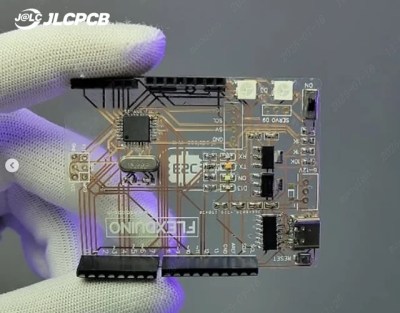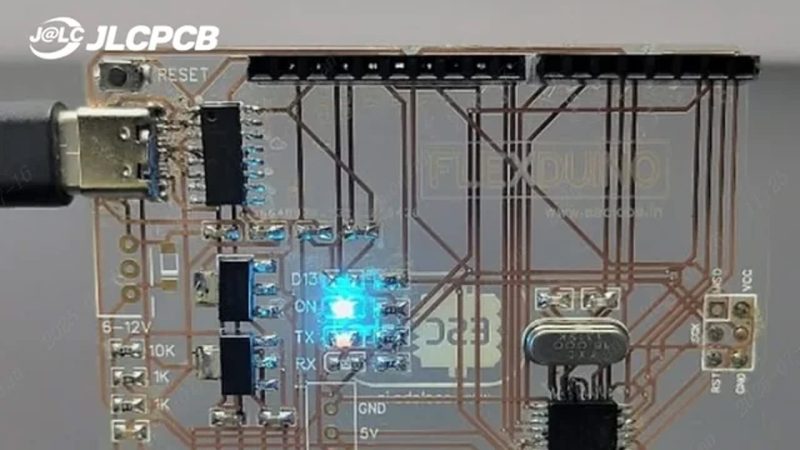What color do you like your microcontroller boards? Blue? Red? Maybe white or black? Sadly, all of those are about to look old hat. Why? Well, as shared by [JLCPCB], this transparent Arduino looks amazing.
 The board house produced this marvel using its transparent flexible printed circuit (FPC) material. Basically, the stuff they use for ribbon cables and flex PCBs, just made slightly differently to be see-through instead of vaguely brown.
The board house produced this marvel using its transparent flexible printed circuit (FPC) material. Basically, the stuff they use for ribbon cables and flex PCBs, just made slightly differently to be see-through instead of vaguely brown.
The circuit in question is a Flexduino, an Arduino clone specifically designed to work on flexible substrates. It looks particularly good on this transparent material, with the LEDs glowing and the white silkscreen for contrast. If you like what you see, you can order your own circuits using this material directly from JLCPCB’s regular old order form.
Most of all, this project reminds us of the 1990s. Back then, you could get all kinds of games consoles and other electronics with transparent housings. There was the beloved PlayStation Crystal, while Nintendo did something similar with the N64 while adding a whole line of tinted color and charcoal versions too. Somehow seeing a bit of the inside of things is just cool. Even if, in some cases, it’s just to avoid smuggling in prisons.
It took decades before you could get custom PCBs quickly and easily. Now, board houses are competing for the enthusiast (consumer?) market, and competition is spurring development of crazy stuff like transparent and even glow in the dark PCBs. What next? We’re thinking edible, ROHS and WEEE be damned. Drop your thoughts in the comments.
Thanks to [George Graves] for the tip!
















I was thinking this would look really cool for multi-layer boards, but many of those layers are often ground-plane copper pours that would block the view…
…we need transparent aluminium ground planes too.
ITO
ITO for traces too would be neat: a transparent slab of plastic with fully operating components just floating on it seemingly disconnected from each other.
It would be both expensive and inferior in terms of resistance; but thanks to the demand for transparent electrodes for things like LCDs and window deicing Indium Tin Oxide thin films are a pretty mature option; as is depositing them on glass or other optically clear materials.
Almost no utility for thermal management compared to a fat copper layer; and definitely not as good for more money; but common and mature enough that ‘more money’ would be “I hope you find this recreational or can command a premium for this novelty” more money; rather than “here’s eleventy-billion to bring Star Trek material science to life” more money.
You’d need to want it; because it would be worse than a normal PCB in basically any respect except coolness; but you wouldn’t need to want it all that badly; especially if you weren’t trying to do leading edge RAM or PCIe6/7 on the board.
Make the ground plane into traces that use as little space as possible.
“but many of those layers are often ground-plane copper pours that would block the view…”
Back In The Day, planes were often hatches rather than solid copper (it’s still done that way in some places for various whatever reasons). It’s obviously worse than solid copper, but any hatch would be better than no ground plane at all.
Graphene. Done.
Can’t do without large pours on high powered design or high frequency design. Lower power and slower devices like UNO clone can be done.
Maybe a transparent C64 clone? They run at 1MHz (far slower than UNO) and could be done without the pours if one made 5v and GND traces wide enough. (there’s also 9v AC but it’s used in just a few spots and wouldn’t be high current) FCC might not like it though.
There was a “Z80 on Glass” prototype by Sharp..
http://www.z80.info/sharp/z80_glas.htm
The original Gameboy had a special edition in a clear case, too.
Where I live, there’s no “prison tech” in clear plastic chassis.
It must be an US American thing, I guess.
Here where I live, the education and scientific sector uses clear plastic, rather.
For demonstration purposes.
It may very well be an American thing. Never really thought about that before. The clear cased prison items sell for an obnoxious premium on the auction site though!
US prisons often had contraband and the rooms were regularly searched for stuff like weed and shivs. Clear TV and clear devices makes it easier for guards to inspect for hidden stuff. No need to open up every TV.
US prison sucks compared to most of the world. They’d rather lock up people than to try and rehabilitate them and help them get a job or mental treatment.
I heard/read about it. Where I live, inmates in certain prisons have their own little room (locked) with personal belongings and the guards try to be respectful/polite.
The concept is to keep them their human dignity and try to re-socalize the inmates, to make them co-operate.
It seems naive at first, likely, but the plan is less about guilt and punishment but to have mentally healthy/stable citizens at the end of the stay,
which then can be safely released back into society.
I’m not saying this the perfect or universal solution,
but it apparently seems to mostly work with the people from this place.
The culture, overall mentality and how they were raised probably has to do with it, too.
Anyway, that’s probably the reason there’s not so much need for see- through appliances,
the inmates here simply have no dire desire to hide something.
Good behavior probably pays off much more.
That doesn’t mean it wouldn’t be cool to have clear electronics nevertheless, though! 😃
It is to make it easier for prison officials to check for banned items.
Wait, is it possible to make vias and microvias in this substrate?
Is the ground plane some kind of transparent metal as well?
I want PCBs made of organic lab synthesized brain material with neural nets and synapses exposed to pinouts.
Printed Circuit Brains it is.
Yes, I too!
Sounds great for the zombie apocalypse too. You could use discarded electronics to distract the hoard while you make your exit.
just made slightly differently to be see-through instead of vaguely brown.
No. not a slight difference. The “vaguely brown” is called polyimide. It´s a polymer that resist relatively high temperatures (solderable).
So, it might be a variant of polyimide (transparent, this exists) or another kind of polymer. And this is not an insignificant detail.
It’s a different polymer. It’s high temperature PET, so way less resilient than kapton (polyimide). With kapton it isn’t even the high temp that’s surprising, kapton holds up even at cryo temps.
I think (not 100%…) that the new Commodore 64 Ultimate announcement said that it has transparent PCBs. I know that the new CEO always used PCBWay in the past, but he may have switched to this company to be a vendor for his company or maybe several companies offer these now…
Your need a lot of luck getting it through EMC qualification if you want this one the open market. Also the soldering looks abysmal.
The transparent PCB is for the mechanical keyboard, not the mainboard.
Only the keyboard PCB is transparent. It’s being made by Jim drew. An old time commodore guy who was previously involved with CBM, utilities unlimited, emplant and currently FPGA arcade fame. I believe the c64 ultimate mb is being made by pcbway as they mentioned they will be visiting PCB to see it being produced.
I thought this was cool back in the 90s but after learning how they use it in prisons a home full of clear-cased electronics became a lot less appealing.
Makes sense. How a separate room for that kind of electronics? A small, little room? “The 90s room”, maybe?
Now we really need those pin headers (male and female) with transparent plastic…
They’ve existed in the 1970s! 😃
Now that’s a great idea I have had so many connection issues. Being able to see the make/female mating surfaces would be fantastic
Yep, most useful comment of the month.
Without a ground plane, the designer would need a lot of luck getting it through EMC qualification, unless it not for sale on the market. And abysmal soldering, but held in white gloves as if it’s some high tech process. But as it’s JLPCB, you get what you pay for. Not that I’m whinging, but it doesn’t look well built at all and not an advert for their work. Today processors require a good ground plane, not only for decoupling which will help with qualification, but that crystal may become susectable to failure even after startup. Although for some applications a clear PCB would be excellent idea especially for use with membrane keyboards with back light buttons using ‘bottom entry’ LEDs (they emit light towards the PCB and need a hole in the PCB to let the light though without attenuating it’s brightness).
This really just seems like a one off proof of concept for the tech. Lacking the ground plane makes sense if they’re trying to show off the transparency rather than create an Arduino clone to sell.
5 years ago French maker Heliox described how to make cirquit boards on glass: https://youtu.be/jvw5OCUHaqc?si=6kXyADFpPWRSBATR or https://hackaday.com/2019/12/01/creating-easy-glass-circuit-boards-at-home/
Could someone please use this tech to put in an order of the Crystal cMoy? (link below) I’ve tried 3 times to make one as beautiful and at this point I think I’m ready to pivot to something that may actually work. https://www.instructables.com/Crystal-cMoy-Free-Form-Headphone-Amplifier/
hackers
Enjoy the laptop, Cool!
While it’s a cool technology, and I can see quite easily how to apply it to artsy projects, there isn’t a lot of information to go on. I prefer to have more information than a Reddit post with just three pictures. Beside that the option is now available at JLCPCB, what can someone learn from this post?
From how I understand flexible PCBs, the substrate is a large temperature range polyamide. The same stuff used for Kapton tape. I would like to learn about this new material which makes transparent PCB possible.
RIP to all signal integrity
This is so interesting! In this thread they talk about in 10 years time having transparent pcbs, here we are 12 years later talking about transparent pcbs. I want a transparent mobo now, don’t care how “ugly” https://linustechtips.com/topic/17804-clear-pcb-motherboards/
I’ve seen plenty of translucent PCB on 90s era TV’s and stereos. Boards that didn’t need a copper backplane.